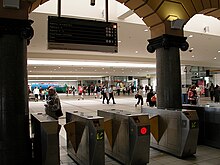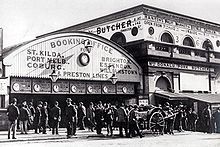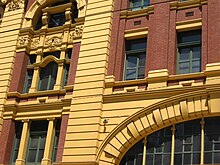Melbourne Flinders Street Railway Station
| Melbourne Flinders Street Railway Station | |
|---|---|
|
Flinders Street Station
|
|
| Data | |
| Design | Through station |
| Platform tracks | 14th |
| Price range | 1 |
| opening | 1854/1910 |
| Architectural data | |
| Architectural style | Neo-renaissance |
| architect | James Fawcett and HPC Ashworth |
| location | |
| City / municipality | Melbourne |
| State | Victoria |
| Country | Australia |
| Coordinates | 37 ° 49 ′ 7 ″ S , 144 ° 58 ′ 3 ″ E |
| List of train stations in Australia | |
The station Flinders Street is the main transport hub of the capital Melbourne the Australian state of Victoria . The station building is on the corner of Flinders Street and Swanston Street and the Yarra River forms the rear of the railroad facilities . The entrance area is at street level and one level higher than the railway systems, which could be designed as a through station in the lower position.
meaning
Flinders Street Station handles around 1,500 trains a day , used by around 65,000 commuters . Flinders Street is Melbourne's busiest station, while Melbourne Southern Cross Station is structurally larger and also has long-distance traffic, but is only used by about half as many passengers.
history
The old train station
The first train station at this point was called Melbourne Terminus . It belonged to the first steam-powered railroad in Australia and was inaugurated on September 12, 1854 together with the Melbourne – Sandrige railway line (today: Port Melbourne). The reception systems initially consisted of a few corrugated iron huts and there was a single, 30 meter long platform . A second platform followed in 1877 and a third in the 1890s. In 1879 a telegraph office was added and a level track was laid to Spencer Street Station (today: Southern Cross). This was moved one level higher on a viaduct in 1889 . Since 1883 there have been two signal boxes in the station.
Across Swanston Street was originally Princes Bridge Station . After the two stations were connected in 1865, Princes Bridge merged with the Flinders Street station .
Today's train station
construction
Since the 1880s, advice was given to modernize this important train station in the city. However, the process dragged on slowly and ultimately lasted more than 20 years. In 1882 the government decided to build a new reception building. But the architectural competition for this was not held until 1899. The competition was won by James Fawcett and HPC Ashworth, who proposed a neo-Renaissance reception building with a dome over the main entrance and a clock tower at the other end of the building. The design was originally developed for the Victoria train station in Bombay . Later interventions in the original planning prevented, among other things, the originally planned platform hall .
The construction work began in 1900, on the station building in 1905. At the same time, the station was expanded to 13 platform tracks. For cost reasons, the building was not made of stone, but of brick instead of the original plan . The cost was £ 93,478. The dome has been erected since 1906. The contractor could not meet the completion date in 1909, was laid off and replaced by the construction department of Victorian Railways . The inauguration took place in 1910.
Reception building
The facade of the reception building with the main entrance at an angle to the intersecting streets of Flinders Street and Swanston Street is considered to be a structural landmark of Melbourne. The building is a cultural monument .
The station building has three floors at the east end and four floors at the west end, as a result of a slope in the terrain. Numerous business premises were built into the long facade facing Flinders Street, and the upper floors were primarily intended for the railway administration.
In the 1960s and 70s, the station building was threatened with demolition several times. Too big, structurally neglected and dirty and a testimony to the historicism that was unpopular at the time , it should be replaced by modern buildings. A corresponding “development contract” had already been signed by the Transport Minister in 1962, but the investor decided on another building site. In 1967 there was another interested party who wanted to build a shopping center over the station area . However, this failed because of the resistance to the project. In 1972 the idea was taken up again, but then had to be abandoned in 1975, when the public began to campaign for the preservation of the historic reception building in the course of the increased appreciation of the historical building fabric. In 1989 the plan came up to "only" build over the areas behind the reception building. However, this failed because the investment sum could not be raised.
In 1982/1984 the historic building was renovated and modernized, which was heavily criticized with regard to its effects on the historical structure, especially in the wing facing Swanston Street . While the facade was left more or less untouched, the interior was heavily interfered with on the entrance level. The entrance area has been tripled for shops and service providers. A city councilor of Melbourne described the interference as " vandalism ", the National Trust of Australia assessed it in 1997 as incompatible with the historical situation.
In 1997/98 the tracks in the station were fundamentally rebuilt so that the Federation Square cultural center could be built on the opposite side of Swanston Street . The Princes Bridge section of the station was also finally removed.
The building was last renovated in 2007: the roof was renewed, disabled access was improved, the ticket counters were all relocated to the main entrance and a passenger information system with LCD screens was introduced across the board.
Clocks
A not so well-known landmark of the station are the clocks that show the departure of the next trains. They play a huge role in local folklore. The clocks date from 1860 and were procured in England . When the old station building was demolished in 1904, they were removed and 28 installed at the four main entrances of the new station building from 1910. They were manually repositioned by a railroad worker using a long pole, an operation that had to be performed about 900 times during an eight-hour shift.
When the clocks were expanded in 1983 with the aim of replacing them with digital displays, there was an outcry through the public that was so great that the decision had to be revised after just one day. At least the historical clocks were preserved at the main entrance, but are now controlled by a computer .
The station has had a clock tower since 1883. As early as 1853, there was a public clock in the immediate vicinity of the later station, which was attached to a water tower that stood until the station's renovation in 1905. The station building from 1910 also received a clock tower, which was built from 1906 onwards. The mechanical watch had to be wound every day. It was sold to a private collector in 1967, but has since found its way into a public technology museum. The clock seen today is operated electrically.
Platforms and traffic

The first electric train on the Victoria railroad ran from Flinders Street Station in 1910 . In 1916, the station is said to have been the busiest in the world.
Tracks 12 to 15 are the eastern extensions of 10, 11 and 1. The platform of track 11 is currently not in use and there is currently no track there. The previously existing tracks 16 and 17 were removed during the renovation in 1997/98. The platforms are connected to each other at three points: Via the main entrance hall, an underpass in the middle of the platforms and another, handicapped-accessible underpass at the western end of the station building.
Transport links
Flinders Street Station is serviced by 10 tram lines and one urban bus route.
literature
- Jenny Davies: Beyond the Façade: Flinders Street, More than just a Railway Station . Ed .: Publishing Solutions. 2008, ISBN 978-1-921488-03-0 .
- Victorian Department of Infrastructure article on Flinders Street Station ( October 29, 2009 memento in the Internet Archive )
Web links
- Flinders Street Station at Culture Victoria
Individual evidence
- ↑ City of Melbourne: Roads> Spencer Street ( July 25, 2008 memento in the Internet Archive )
- ↑ Some Significant Dates in the History of the City of Melbourne ( Memento from August 10, 2008 in the Internet Archive ) (PDF; 39 KiB)
- ↑ Walking Melbourne: Flinders Street Station ( Memento of the original from August 10, 2011 in the Internet Archive ) Info: The archive link was automatically inserted and not yet checked. Please check the original and archive link according to the instructions and then remove this notice.
- ↑ Archived copy ( Memento of the original from March 13, 2011 in the Internet Archive ) Info: The archive link was inserted automatically and has not yet been checked. Please check the original and archive link according to the instructions and then remove this notice.
- ↑ Jodie Misiak: Federation Square: Masterpiece or Publicly-Funded Folly? ( Memento from September 20, 2006 in the Internet Archive ) (PDF; 211 kB).
- ↑ Media Release: STATE GOVERNMENT MOVES TO SAVE MELBOURNE'S MOST FAMOUS DOME. Former link: Archive link ( Memento of the original from March 30, 2011 in the Internet Archive ) Info: The archive link has been inserted automatically and has not yet been checked. Please check the original and archive link according to the instructions and then remove this notice. v. February 28, 2006.
- ^ Melbourne and scenes in Victoria 1925-1926 from Victorian Government Railways From the National Library of Australia








